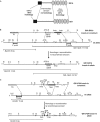Gfi1 and Gfi1b act equivalently in haematopoiesis, but have distinct, non-overlapping functions in inner ear development
- PMID: 16397623
- PMCID: PMC1456886
- DOI: 10.1038/sj.embor.7400618
Gfi1 and Gfi1b act equivalently in haematopoiesis, but have distinct, non-overlapping functions in inner ear development
Abstract
Gfi1 is a transcriptional repressor essential for haematopoiesis and inner ear development. It shares with its paralogue Gfi1b an amino-terminal SNAG repressor domain and six carboxy-terminal zinc-finger motifs, but differs from Gfi1b in sequences separating these domains. Here, we describe two knock-in mouse models, in which the N-terminal SNAG repressor domain was mutated or in which the Gfi1 coding region was replaced by Gfi1b. Mouse mutants without an intact SNAG domain show the full phenotype of Gfi1 null mice. However, Gfi1:Gfi1b knock-in mice show almost normal pre-T-cell and neutrophil development, but lack properly formed inner ear hair cells. Hence, our findings show that an intact SNAG domain is essential for all functions of Gfi1 and that Gfi1b can replace Gfi1 functionally in haematopoiesis but, surprisingly, not in inner ear hair cell development, demonstrating that Gfi1 and Gfi1b have equivalent and domain-dependent, cell type-specific functions.
Figures




Similar articles
-
Gfi1b:green fluorescent protein knock-in mice reveal a dynamic expression pattern of Gfi1b during hematopoiesis that is largely complementary to Gfi1.Blood. 2007 Mar 15;109(6):2356-64. doi: 10.1182/blood-2006-06-030031. Epub 2006 Nov 9. Blood. 2007. PMID: 17095621
-
Direct transcriptional repression of the genes encoding the zinc-finger proteins Gfi1b and Gfi1 by Gfi1b.Nucleic Acids Res. 2005 Feb 17;33(3):987-98. doi: 10.1093/nar/gki243. Print 2005. Nucleic Acids Res. 2005. PMID: 15718298 Free PMC article.
-
The zinc finger transcription factor Gfi1, implicated in lymphomagenesis, is required for inner ear hair cell differentiation and survival.Development. 2003 Jan;130(1):221-32. doi: 10.1242/dev.00190. Development. 2003. PMID: 12441305
-
From cytopenia to leukemia: the role of Gfi1 and Gfi1b in blood formation.Blood. 2015 Dec 10;126(24):2561-9. doi: 10.1182/blood-2015-06-655043. Epub 2015 Oct 7. Blood. 2015. PMID: 26447191 Free PMC article. Review.
-
Gfi1 and Gfi1b: key regulators of hematopoiesis.Leukemia. 2010 Nov;24(11):1834-43. doi: 10.1038/leu.2010.195. Epub 2010 Sep 23. Leukemia. 2010. PMID: 20861919 Review.
Cited by
-
Nascent transcript and single-cell RNA-seq analysis defines the mechanism of action of the LSD1 inhibitor INCB059872 in myeloid leukemia.Gene. 2020 Aug 20;752:144758. doi: 10.1016/j.gene.2020.144758. Epub 2020 May 15. Gene. 2020. PMID: 32422235 Free PMC article.
-
GFI1 proteins orchestrate the emergence of haematopoietic stem cells through recruitment of LSD1.Nat Cell Biol. 2016 Jan;18(1):21-32. doi: 10.1038/ncb3276. Epub 2015 Nov 30. Nat Cell Biol. 2016. PMID: 26619147
-
SUMOylation Regulates Growth Factor Independence 1 in Transcriptional Control and Hematopoiesis.Mol Cell Biol. 2016 May 2;36(10):1438-50. doi: 10.1128/MCB.01001-15. Print 2016 May 15. Mol Cell Biol. 2016. PMID: 26951200 Free PMC article.
-
Deciphering the genetic interactions between Pou4f3, Gfi1, and Rbm24 in maintaining mouse cochlear hair cell survival.Elife. 2024 Mar 14;12:RP90025. doi: 10.7554/eLife.90025. Elife. 2024. PMID: 38483314 Free PMC article.
-
Lsd1 as a therapeutic target in Gfi1-activated medulloblastoma.Nat Commun. 2019 Jan 18;10(1):332. doi: 10.1038/s41467-018-08269-5. Nat Commun. 2019. PMID: 30659187 Free PMC article.
References
-
- Doan LL, Kitay MK, Yu Q, Singer A, Herblot S, Hoang T, Bear SE, Morse HC III, Tsichlis PN, Grimes HL (2003) Growth factor independence-1B expression leads to defects in T cell activation, IL-7 receptor α expression, and T cell lineage commitment. J Immunol 170: 2356–2366 - PubMed
-
- Hertzano R et al. (2004) Transcription profiling of inner ears from Pou4f3 (ddl/ddl) identifies Gfi1 as a target of the Pou4f3 deafness gene. Hum Mol Genet 13: 2143–2153 - PubMed
-
- Hock H, Hamblen MJ, Rooke HM, Traver D, Bronson RT, Cameron S, Orkin SH (2003) Intrinsic requirement for zinc finger transcription factor Gfi-1 in neutrophil differentiation. Immunity 18: 109–120 - PubMed
Publication types
MeSH terms
Substances
LinkOut - more resources
Full Text Sources
Molecular Biology Databases
Research Materials

